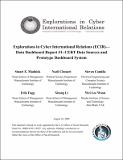| dc.contributor.author | Madnick, Stuart E. | |
| dc.contributor.author | Choucri, Nazli | |
| dc.contributor.author | Camiña, Steven | |
| dc.contributor.author | Fogg, Erik | |
| dc.contributor.author | Li, Xitong | |
| dc.contributor.author | Woon, Wei Lee | |
| dc.date.accessioned | 2022-04-07T16:23:23Z | |
| dc.date.available | 2022-04-07T16:23:23Z | |
| dc.date.issued | 2009-08-10 | |
| dc.identifier.uri | https://hdl.handle.net/1721.1/141750 | |
| dc.description | Disclaimer: This report relies on publicly available information, especially from the CERTs’ pubic web sites. They have not yet been contacted to confirm our understanding of their data. That will be done in subsequent phases of this effort. | en_US |
| dc.description.abstract | Growing global interconnection and interdependency of computer networks, in combination with increased sophistication of cyber attacks over time, demonstrate the need for better understanding of the collective and cooperative security measures needed to prevent and respond to cybersecurity emergencies. The Exploring Cyber International Relations (ECIR) Data Dashboard project is an initial effort to gather and analyze such data within and between countries. This report describes the prototype ECIR Data Dashboard and the initial data sources used.
In 1988, the United States Department of Defense and Carnegie Mellon University formed the Computer Emergency Response Team (CERT) to lead and coordinate national and international efforts to combat cybsersecurity threats. Since then, the number of CERTs worldwide has grown dramatically, leading to the potential for a sophisticated and coordinated global cybersecurity response network. This report focuses primarily on the current state of the worldwide CERTs, including the data publicly available, the extent of coordination, and the maturity of data management and responses. The report summarizes, analyses, and critiques the worldwide CERT network.
Additionally, the report describes the ECIR team's Data Dashboard project, designed to provide scholars, policymakers, IT professionals, and other stakeholders with a comprehensive set of data on national-level cybersecurity, information technology, and demographic data. The Dashboard allows these stakeholders to observe chronological trends and multivariate correlations that can lead to insight into the current state, potential future trends, and approximate causes of global cybersecurity issues. This report summarizes the purpose, state, progress, and challenges of developing the Data Dashboard project. | en_US |
| dc.description.sponsorship | This material is based on work supported by the U.S. Office of Naval Research, Grant No. N00014-09-1-0597. Any opinions, findings, conclusions or recommendations therein are those of the author(s) and do not necessarily reflect the views of the Office of Naval Research. | en_US |
| dc.language.iso | en_US | en_US |
| dc.publisher | © Massachusetts Institute of Technology | en_US |
| dc.relation.ispartofseries | ECIR Working Paper No. 2009-2 | |
| dc.rights | Attribution-NonCommercial-NoDerivs 3.0 United States | * |
| dc.rights.uri | http://creativecommons.org/licenses/by-nc-nd/3.0/us/ | * |
| dc.title | Explorations in cyber international relations (ECIR)—data dashboard report #1: CERT data sources and prototype dashboard system | en_US |
| dc.type | Working Paper | en_US |
| dc.identifier.citation | Madnick, S., Choucri, N., Camiña, S., Fogg, E., Li, X., & Wei, F. (2009). Explorations in cyber international relations (ECIR)—data dashboard report #1: CERT data sources and prototype dashboard system (ECIR Working Paper No. 2009-2). MIT Political Science Department. | en_US |
| dc.eprint.version | Final published version. | en_US |
